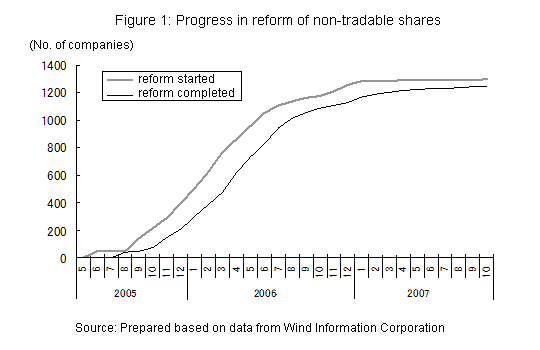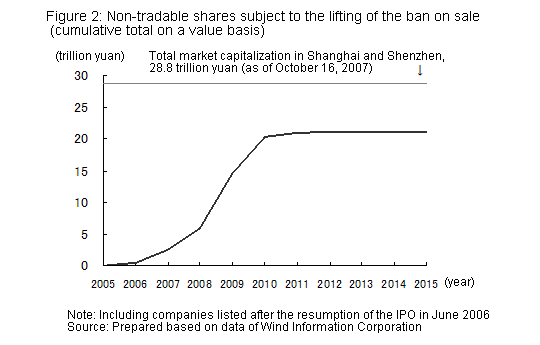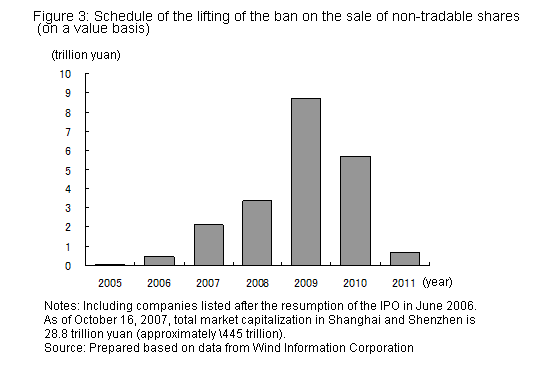With the reform of non-tradable shares beginning in the spring of 2005, China has introduced a system to allow shareholders to sell most of their non-tradable shares (stocks owned by the state or by state-owned enterprises [SOEs]) without restrictions after a certain lock-up period. Non-tradable shares had traditionally accounted for 70% of the outstanding shares on the securities market in China. The reform is gradually correcting, and will eventually eliminate, the two-tier structure of the Chinese securities market, which is composed of both tradable and non-tradable shares. As a result, the interests of tradable shareholders have coincided with those of non-tradable shareholders, and the reform has also paved the way for the privatization of large SOEs through the sale of their shares on the market. Expectations of a resulting improvement in corporate governance and an increase in corporate earnings have been boosting stock prices.
In the meantime, however, the massive sale of stocks owned by the state and SOEs that have become tradable is likely to deteriorate the supply-demand relationship in the stock market, as happened with the unwinding of cross shareholdings in Japan. With the Chinese stock market already experiencing a bubble, with stocks being traded at price-earnings ratios of more than 60, the sale of non-tradable shares could trigger downward pressure on share prices. In fact, when the Chinese authority sold shares in several selected SOEs in 1999 and 2001 on a pilot basis, the overall stock market collapsed on speculation that the sale would be extended to shares in other listed companies.
Drawing on the lessons of this experience, in the latest reform of non-tradable shares the Chinese authority set up a lock-up period during which stocks owned by the state and SOEs cannot be sold even after they have been converted into tradable shares as a means of preserving the supply-demand relationship in the market. More specifically, non-tradable shares will not be allowed to be sold on the market for the first year after they are converted into tradable shares, and the sale of non-tradable shares owned by shareholders who own 5% or more of the outstanding shares of a company may not exceed 5% of the outstanding shares for the subsequent 12 months (in other words, for 24 months after they are converted into tradable shares) and 10% for the subsequent 24 months (or for 36 months after they are converted into tradable shares). Furthermore, some companies have committed to follow more stringent rules such as extending the lock-up period banning the sale of non-tradable shares. These measures have certainly helped support share prices so far, but the lifting of the ban on the widespread sale of stocks is approaching.
As of October 2007, most listed companies - with the exception of certain loss-making enterprises - that are subject to the reform have completed the procedures (figure 1). The schedule for the lifting of the ban on the sale of non-tradable shares is almost decided, based on the reform plans of these subject companies approved at their general meetings of shareholders. According to the schedule, 1.14 trillion non-tradable shares amounting to 20.3 trillion yuan will become tradable by 2010, and the ban on the sale of 661 billion shares amounting to 8.7 trillion yuan will be lifted in 2009 alone. The size of these numbers becomes clear when compared with the current market capitalization of the Chinese stock market, 28.8 trillion yuan (as of October 16, 2007) (figure 2 and figure 3).



Even if the sale of non-tradable shares were to be liberalized, shareholders would still have the option of continuing to hold these stocks as they did in the past. But it seems highly likely that a massive number of non-tradable shares will be sold, given Chinese market characteristics observed in the past. When SOEs were initially transformed into joint-stock companies, their share prices were determined based on net asset values per share, which were much lower than the current prices. Therefore, non-tradable shareholders will be able to earn enormous profits by selling their non-tradable shares. In addition, the fact that share prices have reached a record level gives them a golden opportunity to lock in gains by selling shares they own. Non-tradable shareholders, who are better placed than ordinary investors to understand the actual performance and growth potential of the companies they own, must fully acknowledge that shares are already overvalued.
In addition to the lifting of the ban on the sale of non-tradable shares, a series of large IPOs, including the return of H Shares to mainland markets, are expected to take place. Although the rise in share prices and the inflow of funds are creating a virtuous circle at this point, caution is required. A vicious circle of falling share prices and an outflow of funds could form if share prices enter a correction period triggered, for example, by a sharp increase in supply.
Aware of the risk, the State-Owned Assets Supervision and Administration Commission (SASAC) and the China Securities Regulatory Commission (CSRC) jointly issued in June 2007 the Interim Rules for the Administration of State-owned Shareholders' Transfer of Their Shares of Listed Companies. According to these rules, if the cumulative total number of shares that a controlling state-owned shareholder sells through stock exchanges in three consecutive accounting periods is less than 5% of the total number of shares and if it does not affect control, he/she will have the right to decide whether or not to sell the shares. However, if the cumulative total number exceeds 5% or if the sale affects control, even though the cumulative total number does not exceed 5%, the approval of the SASAC will be required. Investors hope that these rules would help curb deterioration of the supply-demand relationship in the market expected to result from the lifting of the ban on the sale of non-tradable shares.


